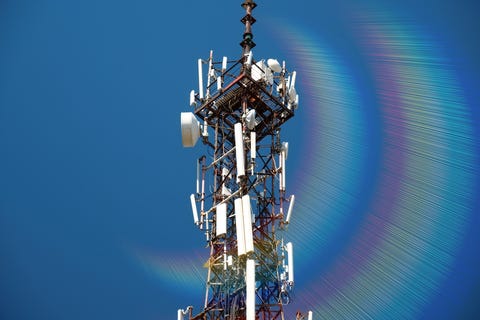QUICK LINKS:
Learn about ECP: Health Center Cleveland, OH | Health Center Ventura, CA
Websites: DrTenpenny.com |Tenpenny Apparel| Tenpenny Supplements
Follow: Twitter | Instagram | Telegram | Truth Social | Podcast Membership|
Broadcasts: Rumble| HappyHour |This Wk wDrT | Brighteon | Bitchute | Tues Coffee
EMFs Everywhere
We are surrounded by electromagnetic frequencies, called EMFs. In fact, the pervasive damage EMFs are causing to every species on the planet is so huge that it’s nearly overwhelming.
The harmful effects of electromagnetic fields (EMFs) may have been documented in the early 1960s. EMFs have been linked to many negative health effects: neurobehavioral disorders, circadian rhythm imbalance (sleep disturbances), headache, fatigue, anxiety, depression, fertility problems, and even cancer. The brain is particularly vulnerable to EMF radiation. In 2018, the textbook, Biolological and Medical Aspects of Electromagnetic Fields, edited by Greenebaum and Barnes, published that the pulse field of 2.45 GHz microwave radiation leads to cognitive impairment and memory loss.
But what about the effect of EMF on the heart?
Beginning in the 1950s, various health issues among radio and radar technicians began to be reported, especially in the Soviet Union. In 1970, an article was published that reported exposure to EMF could affect the structure and function of the cardiovascular system. These changes could lead to myocardial infarction (heart attack) by changing the function of the cardiomyocytes. Exposure to EMFs induced pain or pressure in the chest area, heart palpitations and/or an irregular heartbeat.
Many types of EMFs
Even though we colloquially lump all electromagnetic “noise” into on category, there are actually many frequencies, and each delivers its own type of damage, there are two primary categories:
High-frequency EMFs - Ionizing Radiation - These are at the high-energy end of the electromagnetic spectrum. Examples include x-rays, gamma rays, and certain higher-energy ultraviolet (UV) rays. This type of radiation has long been known to cause genetic mutations and cancer.
Low- to Mid-Frequency EMFs - Non-Ionizing Radiation - These are divided into several categories:
Extremely Low-Frequency (ELF) Radiation: Commonly associated with power lines, household wiring, and electronic devices.
Intermittent Frequencies (IF): Commonly referred to as “dirty electricity” is defined by surges of electrical energy. It can cause flickering and blinking lights, vibrations or noise in equipment, and wiring to run hot.
Radio Frequency (RF) Radiation: Emitted by cellphones, wi-fi routers, and other wireless devices.
Electric Fields: Also produced by household wiring and electronic devices. Electric Fields arise from voltage and can exist even when an appliance is turned off. Plugging a wire into an outlet creates electric fields in the air surrounding the appliance/device.
Magnetic Fields: Generated by household wiring and electronic devices. These fields arise from the flowing of currents that are created as soon as a device is turned on. Magnetic fields and electric fields then exist together in the environment. The greater the current is, the stronger the magnetic field.
Microwave Radiation (MWR): Used in many functions. Here are a few: analog and digital voice, data, and video transmissions. The are the radar used for tracking the weather, used speed guns, and managing air traffic control. MWRs are used in long-distance telescopes and used to transmit thermal energy to heat food and other materials.
Humans, plants, bees, farm animals, and microbes are all affected in various ways by various frequencies. There are at least 1,000 scientific studies worldwide that prove scientifically the harmful biological effects caused by ElectroSmog.
Effect of ElectroSmog
ElectroSmog refers to all man-made electromagnetic radiation present in our surrounding environment. ElectroSmog occurs everywhere that an electric current flows. The amount we are exposed to daily through exposure to wireless S-band frequencies used in our many technologies is accelerating. ElectroSmog exposure has dramatically increased during the last years due to both 5G and because we use so much more digital technology than ever before. We constantly use mobile phones and laptop computers for Internet shopping, online banking, zoom meetings, and on and on. This means we are exposed to ElectroSmog 24 hours a day, seven days a week – even if we aren’t using our mobile phone or computer, the radiation is still there.
Termed Electrohypersensitivity Syndrome (EHS), the condition most commonly presents heart palpitations with chest pain or pressure, accompanied by anxiety, typical of the "fight-or-flight" response. Despite its repercussions on the lives of the affected persons, EHS still eludes the efforts to objectify it. It remains a self-diagnosed condition without an objective way to diagnose it and very few ways to treat it. Unfortunately, many sufferers who report a wide range of troubling conditions - sleep disorders, headaches, dizziness, memory and concentration difficulties, abnormal and diverse musculoskeletal pains, skin conditions, and mood disorders - are labeled as ‘hypochondriacs,’ and their conditions are not taken seriously.
In 2013, Dr. Magda Havas published a study in the peer-reviewed journal, Reviews on Environmental Health. Her research found that EHS may be associated with clumping (rouleau formation) of the red blood cells. She went on to defend patients with EHS by confirming:
Provocation studies have shown EHS is a physiologic condition. It is not psychosomatic. Those who experience prolonged and severe EHS may indeed develop psychological problems as a consequence of their inability to work, their limited ability to travel, and the social stigma that their symptoms are imagined rather than real.
In an earlier study (2010), Havas and colleagues found that individuals who are hypersensitive to microwave radiation react to levels well below federal guidelines (5 micro/cm2 or 0.5% of guidelines in Canada & U.S.). During real-time monitoring of the heart while exposed to the radiation given off by a cordless phone base station, some individuals experienced an irregular heart rate or a rapid heart rate during the EMF exposure but not during sham exposure (when the radiation was off). This is the first study showing such dramatic and repeatable results.
In a recently published study (2023) titled, Electromagnetic Fields - Do They Pose a Cardiovascular Risk?, researchers enrolled 30 healthy persons (15 women) aged 20–30 with trim body mass index (BMI): 23.3± 3.5 kg/m2). They were very fit, had no underlying pathologies, and were not taking any medications. Each person had HRV (heart rate variability) assessments after exposure to 2.4 GHz (frequency of Wi-Fi) and 2.6 GHz (frequency of 4G network) applied to their chest.
Results: This was the first study to demonstrate a distinct shift in heart rate autonomic regulation towards sympathetic overactivity (Wi-Fi) and parasympathetic underactivity (4G). It seems that EMF exposure results in cardiac autonomic dysregulation, which may lead to a higher risk of cardiovascular complications later in life.
The limitations of this study are obvious: It only included 30 persons, but more importantly, they were young, healthy, on no meds, and exposed to 4G technology. How dramatic would the adverse events have been on older persons with cardiovascular disease, on medications, and if this study had included 5G exposure?
Cardiac Damage from S-Band Radiation
S-band frequencies (2.0 to 4.0 GHz) are used for satellite communication and radar in the shipping, aviation, and space industries. However, S-band radiation also has an extensive range of consumer applications, including:
cordless phones
wireless headphones (Bluetooth)
wireless networks (WiFi)
inflight WiFi
garage door openers
keyless vehicle locks
baby monitors, and
microwave ovens.
In healthcare, S-band radiation is used in surgery to cauterize blood vessels and is particularly valuable in neurosurgery and surgery of the eye.
The heart is regulated by both neurological and endocrine systems. Studies have shown that the heart’s contraction and blood flow require a lot of energy, so myocardial tissue is rich in myocardial fibers and mitochondria. A flood of studies have shown that microwave radiation, specifically S-band frequencies, can cause myocardial structural damage, especially mitochondrial structural damage.
A 2023 study was designed to determine the effect and mechanism of cardiac injury caused by S-band radiation. This is a long paper, but it concluded that after only 35 minutes of exposure to S-band radiation, rats showed increased heart muscle damage, heart muscle mitochondrial dysfunction, cellular oxidative stress, and abnormal HRV testing. Reduced HRV is an increased risk for heart disease and mortality. This study also showed the results were worsened when coupled with either physiological or psychological stress. (So, more time on your cell phone, especially when stressed, really affects your heart and blood pressure!)
Warnings
In 2015, more than 180 scientists and physicians of 36 countries turned to the European Union and warned about the dangers of 5G. The scientists signed an affidavit requesting the EU to follow a resolution passed by the Council of Europe, in which an independent work group is being demanded to reassess health effects, stating the following:
“We, the undersigned scientists, recommend a moratorium on the roll-out of the fifth generation, 5G, for telecommunication until potential hazards for human health and the environment have been fully investigated by scientists independent from industry.
5G will substantially increase exposure to radiofrequency electromagnetic fields (RF-EMF) on top of the 2G, 3G, 4G, WiFi, etc., for telecommunications already in place. RF-EMF has been proven to be harmful to humans and the environment.”
Solutions
Every person in the USA and around the world is living under the inescapable assault of broadcast frequencies (AM/FM/TV), plus 2G, 3G, 4G/LTE, and Wi-Fi microwaves, all delivered simultaneously to the environment at up to 6 billion hertz. It seems the more the FCC knows about the dangers of EMF and 5G radiation, the more it doubles down on its position to push untested radiation on the uninformed public.
Governments are pushing out tens of millions of 5G antennae without any biological safety testing. The 5G millimeter wave frequencies present an additional, highly elevated risk for cardiovascular pathologies. In fact, this article, while long it’s worth reading. It exposes how extensive the problem really is.
Here are a few suggestions to get you started to reduce cell phone radiation exposure:
Use speaker mode. Place as much distance between your head and the cell phone as possible.
Don’t give cell phones to young children as toys or pacifiers.
Take care of your older children. Give your children a cell phone for safety reasons; also, give them an EMF-resistant headset and encourage them to use the phone’s speaker.
Use EMF-resistant headsets and earbuds. We’re a fan of DefenderShield.
Keep the phone off your body. Carry your phone in a purse or bag with the antenna (back of the phone) pointed away from you, not in your pocket or bra.
Turn it off. Reduce the amount of time spent using your cell phone.
Really, turn it off. Phones only emit EMF radiation when they’re searching for or receiving a signal. A phone that is off or in “airplane mode” is safe.
EMF protection for your home - I have my entire home and my podcast studio protected by EMF Sol.
+++++++++++++++++++++++++++++++++++
The amount of information on the damaging effects of EMFs on the heart is staggering. I will only be able to touch on a bit of the information here. For more details, here are a few references in no particular order:
This website lists so many sources - and solutions - if you’re not familiar with the topic, start here.
Website of Dr. Magda Havas, PhD -
Article: Electromagnetic hypersensitivity: critical review of explanatory hypotheses
Cell phone radiation: a symposium
Medical studies of heart disease and EMF:
Monograph from International Commission for Electromagnetic Safety (many studies) (2010)
Environmental Working Group (EWG) report on EMFs and heart health
Effect of EMFs on the gastrointestinal tract









So much thoughtful and well-organized information to digest here. Thank you, Dr. T. It's been told many times that a good doctor is always concerned with the welfare of their patients. Sherri, thank GOD, we have you as ours.
GOD bless you!
Smartphones cannot be turned off. Turning them "off" only deactivates the screen and the buttons. Their cameras and microphones remain on and under the control of the cellular network they are assigned to. Anything their microphone hears and/or their cameras see is either stored in their memory or sent onto the network, unless they are put into airplane mode, which is the only way to stop one from emitting EMF.